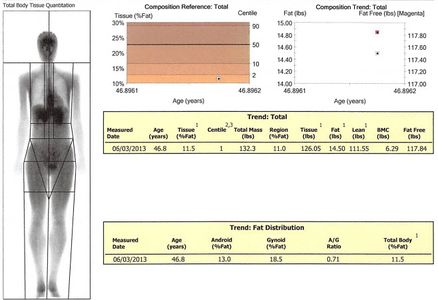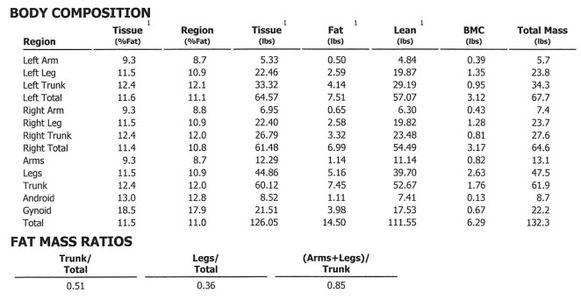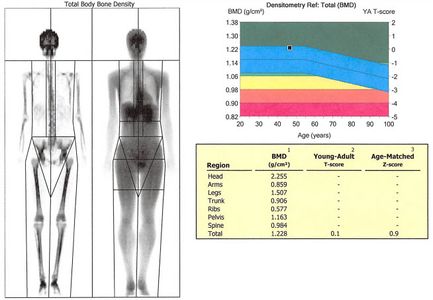DEXA
DEXA (Dual-energy X-ray absorptiometry) uses two types of X-Ray beams to determine body fat and bone density. DEXA is more accurate than underwater weighing[1], which was previously considered the "gold standard" for clinical measurement of body composition. There are a number of advantages to DEXA over other techniques.
- DEXA is the most accurate method commercially available (see below for details). It is now the mostly widely accepted method of measuring body composition in clinical settings[2].
- The process is quick and comfortable. The actual scan takes 5 minutes or so, and all you have to do is lie still.
- While DEXA involves X-Rays, the level is trivial[3]. Having a DEXA scan gives you the same level of radiation as 3 hours of average background radiation. By comparison, a chest X-Ray gives 100x the radiation of a DEXA scan and a CAT scan can give 10,000x the radiation of DEXA.
- Not only will DEXA give body fat information, it also provides details of bone density.
- DEXA provides a detailed breakdown of how much lean tissue and body fat are present in each area of the body. This breakdown will show the composition of each arm, and leg, as well as the trunk.
- The trunk area is broken down into Android and Gynoid areas; Android obesity is the "apple" shape with fat is in the trunk and Gynoid obesity is the "pear" shape with increased fat in the hip and thigh areas. Fat deposition in the android region is associated with increased risk of cardiovascular disease, hypertension, hyperlipidemia, insulin resistance, and type-2 diabetes, while Gynoid fat deposition is associated with decreased risk of metabolic and cardiovascular diseases[4][5].
- Because a DEXA scan gives details of lean tissue for each arm and each leg, it can give an idea of muscle imbalance.
The only significant downside to DEXA is the cost. I went to a local weight loss clinic for my scan which cost $150, though they offer a series of 4 scans for $400. You can use DEXA to calibrate another form of body fat measure, such as Body Fat Scales.
1 Example DEXA Report
The images below are taken from my DEXA scan, though different DEXA systems may report different details.
2 Accuracy of DEXA
While DEXA is the best practical method of determining body composition, its accuracy is not perfect. The best methods we have for determining the body composition of a living human are called "four component models" (4CM) which divide the body into water, protein, mineral, and fat using radioactive isotopes to determine total body water and total body potassium[6][7]. These methods are impractical, even in most clinical settings, but they can be used to evaluate DEXA and other techniques. A study of 152 people showed that DEXA corresponds well with the 4CM, but not perfectly[8]. The graph below shows that DEXA tends to underestimate the body fat of leaner individuals. For DEXA values of 10, 20, and 30% body fat the 4CM showed 13.0, 21.6, and 30.3%, respectively. Overall, the DEXA scan had errors of up to −2.6 to 7.3% body fat, but the average error was only 1.6% (+/-0.8%).
3 References
- ↑ JE. Pritchard, CA. Nowson, BJ. Strauss, JS. Carlson, B. Kaymakci, JD. Wark, Evaluation of dual energy X-ray absorptiometry as a method of measurement of body fat., Eur J Clin Nutr, volume 47, issue 3, pages 216-28, Mar 1993, PMID 8458318
- ↑ http://www.cdc.gov/nchs/nhanes/nhanes2003-2004/DXXAG_C.htm, http://www.cdc.gov/nchs/nhanes/nhanes2003-2004/DXXAG_C.htm, Accessed on 9 June 2013
- ↑ Patient Safety - Radiation Dose in X-Ray and CT Exams http://www.radiologyinfo.org/en/safety/index.cfm?pg=sfty_xray#part3
- ↑ AR. Folsom, LH. Kushi, KE. Anderson, PJ. Mink, JE. Olson, CP. Hong, TA. Sellers, D. Lazovich, RJ. Prineas, Associations of general and abdominal obesity with multiple health outcomes in older women: the Iowa Women's Health Study., Arch Intern Med, volume 160, issue 14, pages 2117-28, Jul 2000, PMID 10904454
- ↑ AH. Kissebah, GR. Krakower, Regional adiposity and morbidity., Physiol Rev, volume 74, issue 4, pages 761-811, Oct 1994, PMID 7938225
- ↑ Fuller, N. J., et al. "Four-component model for the assessment of body composition in humans: comparison with alternative methods, and evaluation of the density and hydration of fat-free mass." Clinical Science 82.Pt 6 (1992): 687-693.
- ↑ SB. Heymsfield, S. Lichtman, RN. Baumgartner, J. Wang, Y. Kamen, A. Aliprantis, RN. Pierson, Body composition of humans: comparison of two improved four-compartment models that differ in expense, technical complexity, and radiation exposure., Am J Clin Nutr, volume 52, issue 1, pages 52-8, Jul 1990, PMID 2360552
- ↑ GE. Van Der Ploeg, RT. Withers, J. Laforgia, Percent body fat via DEXA: comparison with a four-compartment model., J Appl Physiol, volume 94, issue 2, pages 499-506, Feb 2003, doi 10.1152/japplphysiol.00436.2002, PMID 12531910



